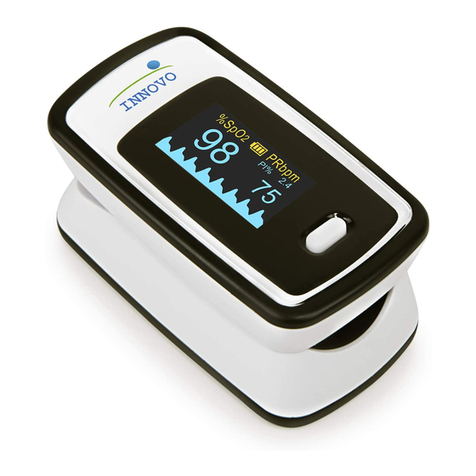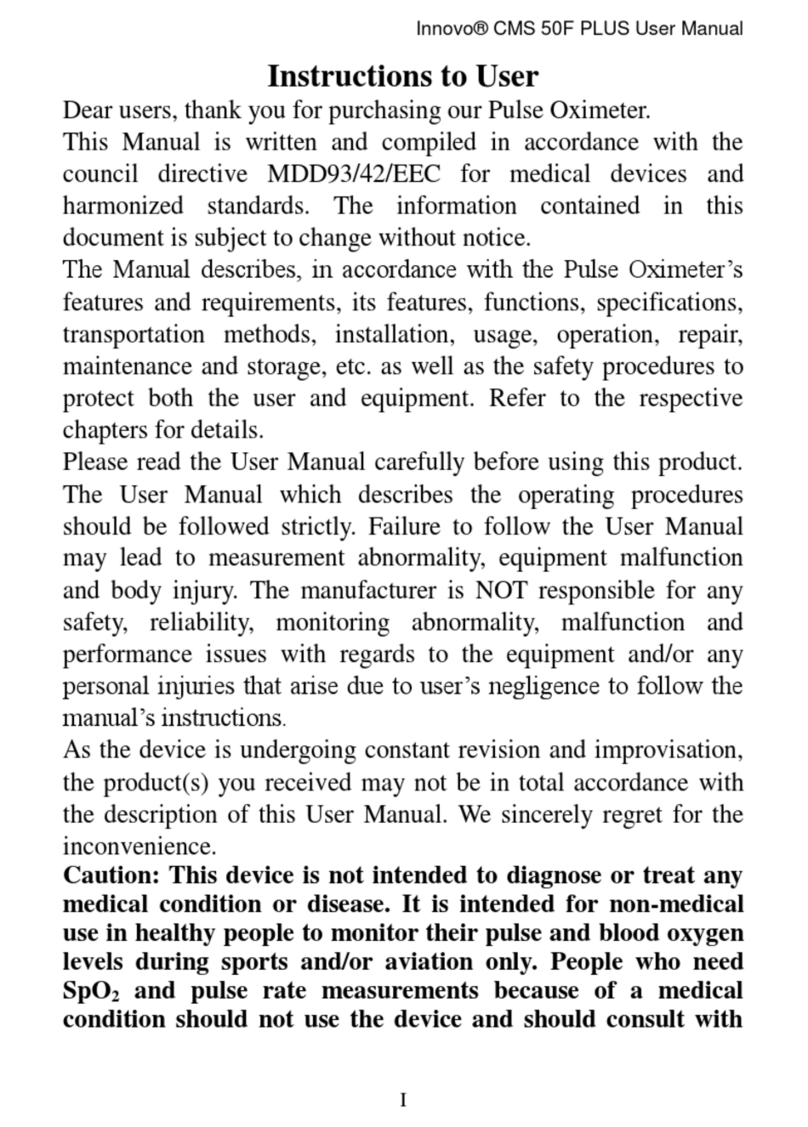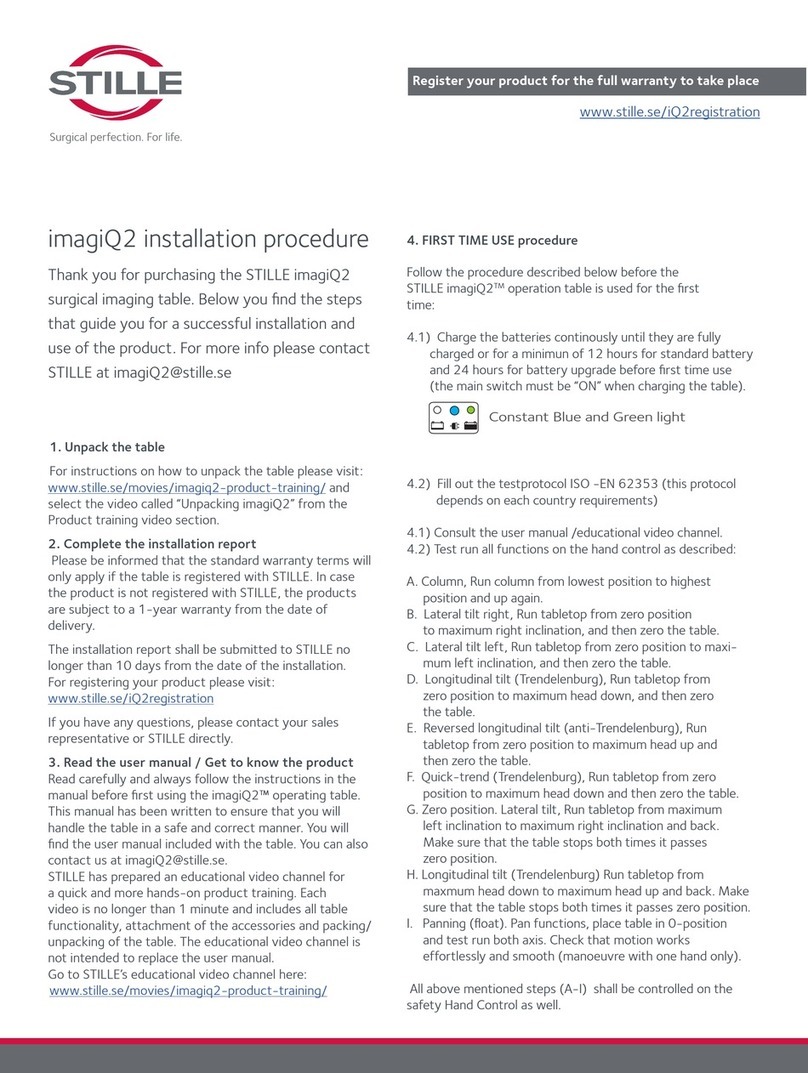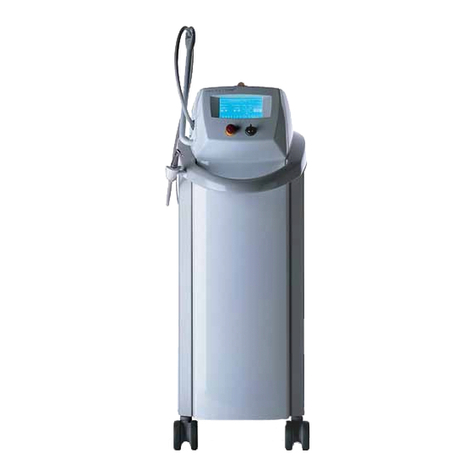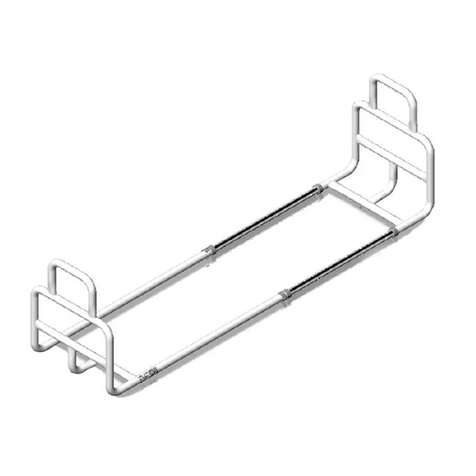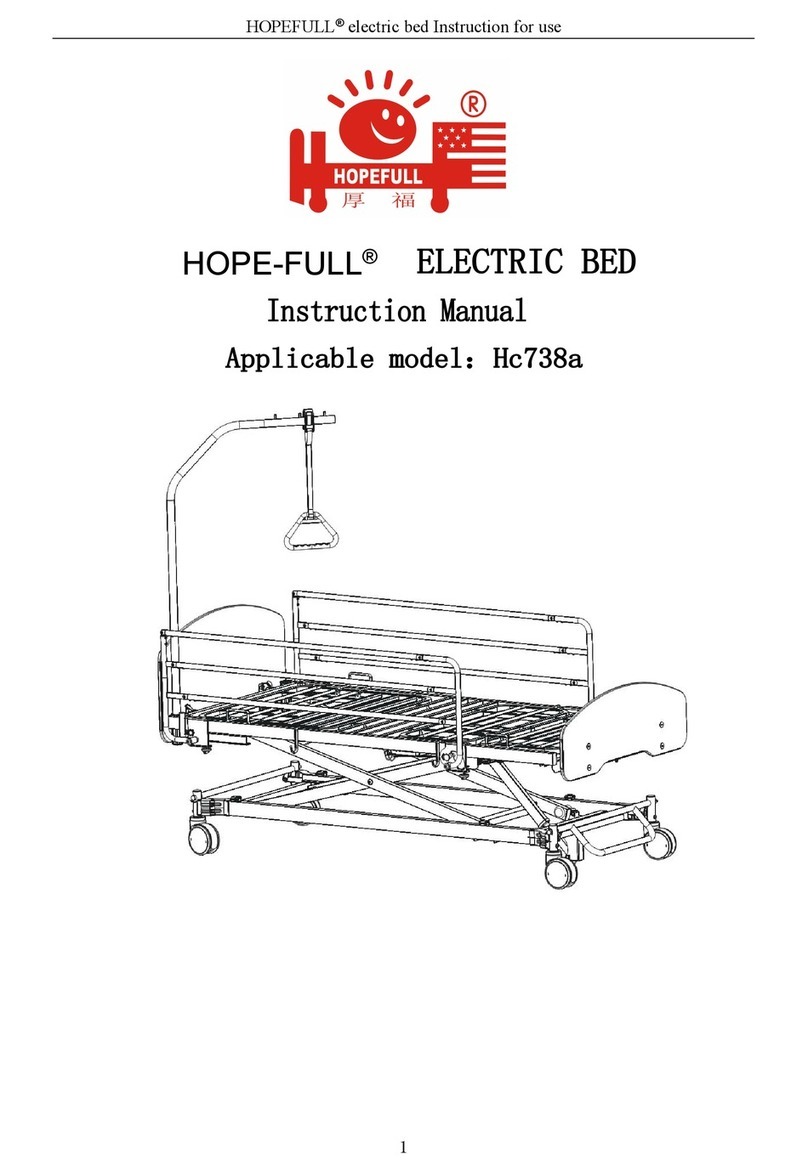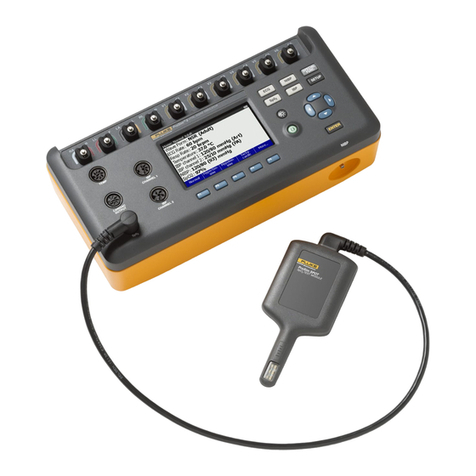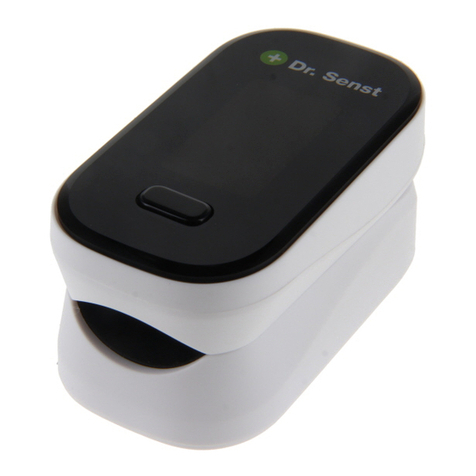Innovo INV-430J User manual

Pulse Oximeter INV-430J/PE
Precautions
Do not attempt to repair the Pulse Oximeter by yourself. Only
certified engineers should maintain and repair it.
Change the contact position between the Oximeter probe and
the finger periodically if you are monitoring your SpO2 levels
and pulse rate for more than 2 hours.
This product is not designed to be used by newborn babies.
Seek for medical care if the measured value goes beyond the
normal range and you are sure that the instrument is not
malfunctioning.
The pulse oximeter uses infrared light (invisible to your eyes) to
measure your SpO2levels. Hence, please do not stare at the
light-emitting components of the Oximeter, as that could cause
harm and/or potentially blind your eyes.
For details about clinical limitations and contraindications,
please carefully consult relevant medical literatures.
The following factors may affect the accuracy of measurement:
◆The Oximeter is used in an environment involving
high-frequency devices, such as high-frequency electric knives
and CT apparatuses.
◆The probe of the Oximeter is placed on the same arm that a
blood pressure cuff arterial duct or intravenous injection.
◆The user suffers from hypotension, severe vascular atrophy,
severe anemia, or low oxygen.
◆The user is in sudden cardiac arrest or shock state.
◆The user is wearing nail polish or artificial nails.
Warning: Do not use the Oximeter in an environment with any
flammable gases, flammable anesthetic, or other flammable substances.
Warning: Keep unit and lanyard away from children as the included
lanyard may present an entanglement or choking hazard to small
children.Adult supervision required; never leave children unattended
with unit or lanyard.
Warning: Do not throwthe batteries into fire, as that could cause an
explosion.
Warning: Do not attempt to charge the included batteries, as that could
cause leakage, fire disaster, or even explosion. Dispose the used
batteries in accordance to the local laws and regulations.
Warning: Do not use the Oximeter in an MRI or CT environment.
Warning: Do not operate the Oximeter if it is wet. Avoid moving the
oximeter from a cold to a hot and humid environment.
Warning: Install the batteries properly before powering on the Oximeter
for normal use. Please remove the batteries if you are not planning to
use the Oximeter for a long time.
Warning: Close the battery cover when the instrument is in use.
Symbol Conventions
Symbol
Description
BF-type application part
Caution: Please see this manual.
%SpO2
Symbol of oxygen saturation
bpmPR
Symbol of pulse rate
Temperature limitation
When end users abandon this product, they
must send the product to the collection place
for recycling.
Manufacturer information
Overview
SpO2stands for peripheral capillary oxygen saturation. Oxygen
saturation is defined as the ratio of oxyhemoglobin (HbO2) to the total
concentration of hemoglobin (i.e. Oxyhemoglobin + reduced hemoglobin)
present in the blood. It is an important physiological parameter involved
in respiration and circulation. The Pulse Oximeter feature herein is small,
portable, non-invasive and easy to use. The user only needs to insert a
finger into the chamber to measure his/her SpO2and pulse rate.
Working Principles, Expected Usage, and Applicable Scope
Oxygenated blood absorbs light at 660nm (red light), whereas
deoxygenated blood absorbs light preferentially at 905nm (infra-red). A
pulse oximeter works by passing a beam of red
and infrared light through a pulsating capillary
bed and then measure the amount of red and
infrared light emerging from the tissues via a
sensor. To improve accuracy, the NV-430J/PE
uses a proprietary algorithm to collect data from pulsatile arterial blood
and ignores local noise from the tissues. The relative absorption of light
by oxyhemoglobin (HbO) and deoxyhemoglobin is then processed
according to the Beer-Lambert's law and a qualitative measurement of
the users’ oxyhemoglobin status i.e. Oxygen saturation level (SpO2)
derived.
This device is intended for non-medical use in healthy people to monitor
their pulse and blood oxygen levels for sports and/or aviation only. Do not
use for continuous monitoring.
Limitations
Spot check pulse oximeter takes 1-2 reading every second and takes an
average of 3-6 readings before displaying the result. Hence, you will
have to wait at least 3-6 seconds before a result will be displayed on the
monitor. If the pulse oximeter fails to detect blood flow for the first few
seconds, then the results will be delayed accordingly.
The pulse oximeter does not work for people with naturally small fingers
or low peripheral blood flow. This is because the pulse oximeter would
not have enough blood to take a measurement. Please note that prolong
use of a pulse oximeter, hypotension, vasoconstriction, hypothermia and
certain medications can lead to low or restricted blood flow. Nail polish
can also impede the pulse oximeter from taking a reading.
Finally, it is generally accepted that the saturation percentage is
unreliable on the steep part (around 60 mm Hg) of the oxyhemoglobin
dissociation curve.
Innovative features of the INV-430J/PE
The INV-430J/PE attempts to ameliorate some of the above problems by
1) Increasing the sensitivity of the sensor so that it can measure the
user’s SpO2and Pulse Rate (PR) at blood perfusion Index (PI) as low as
0.2%.
2) Comes with anti-motion technology so that the pulse oximeters can
still function even when the finger moves.
3) Using a self-adjusting smart spring system to fit the finger snugly but
not so tight as to impede blood flow that might lead to a low PI.
4) Using soft, hypoallergenic medical grade silicon in the finger chamber
so that the pulse oximeter will not cause discomfort.
4) Using solidABS plastic to block ambient light from reaching the sensor
so that the signal to background ratio and the accuracy of the
measurement is dramatically increased.
5) Having a plethysmograph that allows the user to see and gauge the
amount of blood detected by the pulse oximeter. This will allow the user
to know if the finger is properly inserted into the finger chamber and if the
pulse oximeter is taking the measurements properly (See below for
details)
Operation Guide
Switch on the power supply of the pulse Oximeter
Stick one finger completely into the
finger chamber of the Oximeter. The
fingernail should be facing upward.
Release the clip and press the power
key to power on the Pulse Oximeter.
The INV-430J/PE pulse oximeter
sensor
Light beams
sensor

comes with anti-motion technology so that the pulse oximeter can
function even if there is finger movement. However, for best results, try to
keep your finger still during measurement. It is also not advisable to use
this instrument during sports activities as movement may lead to
inaccuracies. Once the reading stabilizes, read the measured values of
oxygen saturation and pulse rate on the OLED screen. The Oximeter will
automatically shut down 10 seconds after you remove your finger.
If you do not insert your finger completely into the chamber
the measurement will be inaccurate.
Replace the batteries when the batteries are low and the
symbol flickers on the screen.
Schematic Diagram of Display
The following figure shows the information display on the OLED screen
of the Oximeter in normal detection state:
Symbol of oxygen saturation
Measured value of oxygen saturation
Bar graph
Plethysmograph
Measured value of pulse rate
PI
Symbol of pulse rate
Battery power indication
Power-On Key/Function Key Operations
PRESS (<0.5 sec) the power-on/function key to turn on the pulse
oximeter. Once it is turned on, HOLD (>0.5 sec) the power-on/function
key to enter into the menu interface. PRESSING (<0.5 sec) on the
power-on/function key will allow you to to scroll through options while
HOLDING (>0.5 sec) it will select an item. "*" indicates the option you are
currently at (Please see figure below).
Alarm Sound Setting
To turn the alarm on/off, PRESS the power-on key/function key to move
"*" to Alm. HOLD the power-on key/functional key to switch the option
from on to off or vice versa. When Alm is set to on and the measured
values of the blood oxygen saturation (SpO2) and/or pulse rate (PR) go
beyond the stated upper or lower limit (See Alarm Range Setting to set
parameters for Alarm), the alarm will go off. When Alm is set to off, the
alarm is deactivated. The alarm will not go off regardless of your SpO2
and/or PR values.
Brightness Setting
To change brightness, PRESS the power-on key/function key to move "*"
to brightness. HOLD the power-on key/function key to set the
brightness. There are 5 brightness settings. 5 is the brightest. The factory
default setting is 4. Please note that a brighter setting will drain the
battery faster.
Interface 1 Interface 2
Plethysmograph
The INV-430J/PE comes with two invaluable features, the
plethysmograph and the perfusion index, that help the user determine if
the readings are accurate and reliable. The plethysmograph indicates the
amount ofblood flow detected by the pulse oximeter and the perfusion
index (PI) indicates the strength of your pulse. Each wave in the
plethysmograph (see above) corresponds to a heartbeat and the wave
amplitude corresponds to the amount of blood detected by the pulse
oximeter flowing through the blood vessels. The pulse oximeter is
optimized when the height of the wave amplitude is consistent
throughout as shown in the figure above. That is when you should take
the reading. The pulse oximeter can function with a PI reading as low as
0.2. However, if your PI is below 0.2%, this means that your blood
perfusion is too low for a reliable read. Please warm your hands to
increase bloodflowand retake your measurement to make sure that your
finger is positioned right under the LED lights. Most of the time, a higher
PI will give you a more reliable reading.
Alarm Range Setting
To change the alarm range settings, HOLD the power-on/function key to
enter Menu Interface 1.With the "*" next to Alm Setup, HOLD the
power-on key/function key to enter in Menu Interface 2. "*" should be at
Sounds Setup. Press the power-on key/function key to move "*" to the
option you desire to change. SpO2Alm Hi and SpO2Alm Lo refer to the
upper and lower limit of the SpO2levels that you wish the alarm to go off
at respectively. PR Alm Hi and PR Alm Lo refer to the upper and lower
limit of the Pulse Rate levels that you wish the alarm to go off at
respectively.
While the "*" symbol stays on the +/- option, hold the function key to set
the option to + or -. In + mode, select the corresponding upper or lower
limit option and hold the function key to increase the upper or lower limit;
in - mode, hold the function key to decrease the upper or lower limit.
Move "*" to the Exit option, and hold the function key to return to the
monitoring interface.
About the Display
PRESS (<0.5 sec) the function key in measurement mode to change the
display mode. The six different modes are shown in the figure to the right.
Choose the mode that is the most convenient for you.
Cleaning
To clean the instrument, power off and remove the batteries first. Then
clean the outer surface of the instrument (including the LED screen)
using a piece of dry soft cloth dipped with 75% medical alcohol. Do not
immerse the unit in alcohol.
Caution: Do not use anystrong dissolving agent such as acetone.
Caution: Do not rub the body of the instrument using materials such as
steel wire balls or polished metal objects.
Caution: Ensure that there is no washing liquid on the surface of the
instrument.
Caution: Do not allow liquid to flow into the instrument during cleaning.
Caution: Do not immerse any part of the instrument into any liquid.
Disinfection
Before measurement with the instrument, wipe the rubber finger pad
inside the chamber using a piece of dry soft cloth dipped with 75%
medical alcohol. Clean the finger to be measured using the medical
alcohol for disinfection purposes before and after use.
Do not disinfect the instrument by using
high-temperature/high-pressure disinfecting gas.
Maintenance
Remove the batteries from the battery slot and properlystore them
if you do not plan to use the Oximeter for a long period of time.
Replace the batteries if they are low on power.
Clean the Oximeter and the fingertip before use to ensure
accurate reading.
Store the Oximeter between 14 and 122F (–10 to +50C) and at
humidity levels no greater than 93%.
Periodically check the Oximeter for damage.
Avoid using the Oximeter in an environment with flammable gases
or using it in an environment where the temperature or humidity is
V2.01.E
Alm setup *
Alm on
Beep off
Demo off
Restore ok
Brightness 4
Exit
V2.01.E
Sounds Setup *
SpO2Alm Hi 100
SpO2Alm Lo 94
PR Alm Hi 130
PR Alm Lo 50
+/-+
Exit
Plethysmograph

excessively high or low.
Check the accuracy of the oxygen saturation and pulse rate
readings by using an appropriate calibration apparatus.
Technical Specifications
1. Dimensions: 62.0 mm (Width) × 37.0 mm (Depth) × 32.0 mm
(Height)
Weight: 42.5 g (including the height of the two AAAdry batteries)
2. Peak wavelength range of the light emitted from the probe: red light
660 nm ± 3; infrared light 905 nm ± 5.
3. Maximum optical output power of the probe: 1.2 mW for infrared light
(905 nm).
4. Normal working condition
Working Temperature
5C to 40C (41F to 104F)
Relative Humidity
15% to 80%, non-condensing
Atmospheric Pressure
70 kPa to 106 kPa
Rated Voltage
DC 3.0 V
5. Default values andconditions of alert
Parameter
Value
Oxygen saturation
Upper limit: 100
Lower limit: 94
Pulse rate
Upper limit: 130
Lower limit: 50
Alert condition
When the alert switch is on and the
actual measured value goes beyond
the preset alert parameter range, the
Oximeter gives an alert sound.
6. Technical parameters
Parameter
Value
Display range
Oxygen
saturation
35% to 100%
Pulse rate
25 bpm to 250 bpm
Resolution
Oxygen
saturation
1%
Pulse rate
1 bpm
Measurement
precision
Oxygen
saturation
±2% (70% to 100%)
No requirement (≤ 69%)
Pulse rate
±2 bpm
Alert range
Oxygen
saturation
Upper limit: 50% to 100%
Lower limit: 50% to 100%
Pulse rate
Upper limit: 25 bpm to 250 bpm
Lower limit: 25 bpm to 250 bpm
Alert error
Oxygen
saturation
± 1% of the preset value
Pulse rate
The greater of ±10% of the preset
value and ±5 bpm
PI
Weak PI
Min. 0.2%
Safety Type
Anti-electric-shock type: internal power supply device
Anti-electric-shock degree: BF-type application part
Running mode: continuous working
Waterproof grade: IP22
6.4 Storage and Transportation
Innovo Groups
Phone: +1-858-888-9781
cs@innovogroups.com
http://www.innovogroups.com
This manual suits for next models
1
Other Innovo Medical Equipment manuals
Popular Medical Equipment manuals by other brands
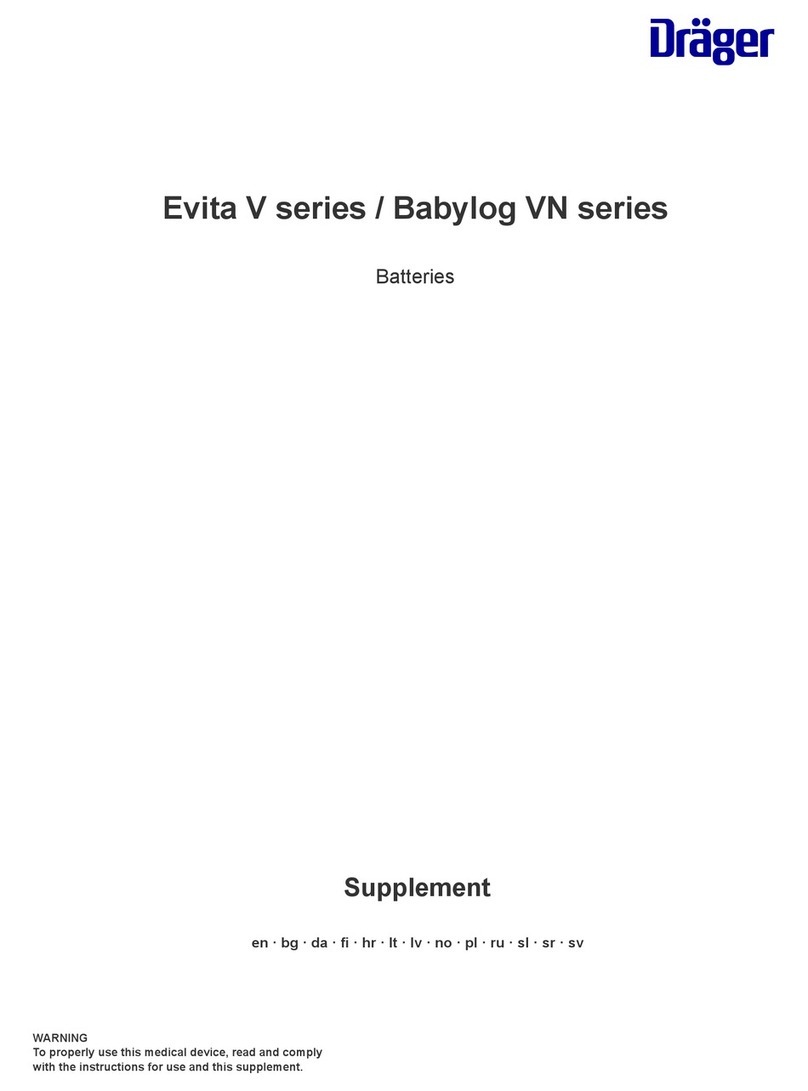
Dräger
Dräger Evita V Series Supplement to the instructions for use
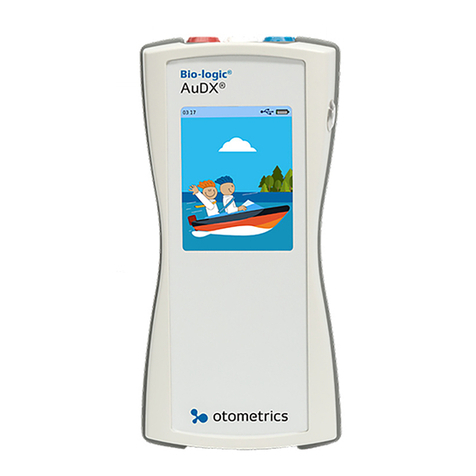
natus
natus Otometrics Bio-logic AuDX PRO quick start guide
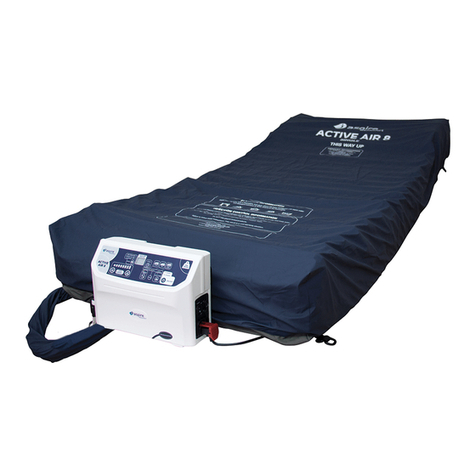
Aspire
Aspire ACTIVE AIR 8 user manual
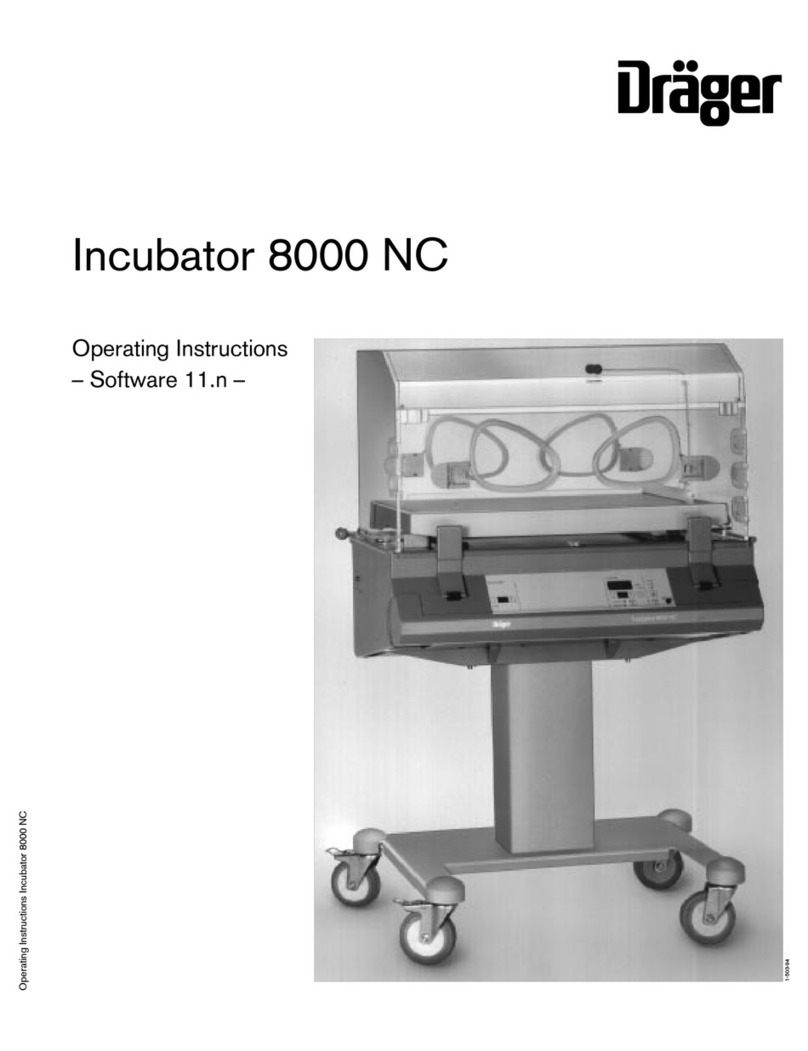
Dräger
Dräger 8000 NC operating instructions

Medline
Medline MDS705154 instruction manual
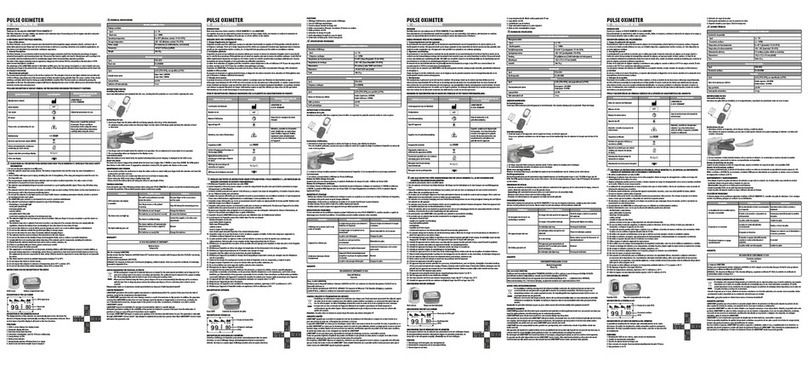
Lanaform
Lanaform PULSE OXIMETER S1 Instructions for use

Pari
Pari bubbles the fish ii Instructions for use

Orliman
Orliman OSL4340 Use and maintenance instructions
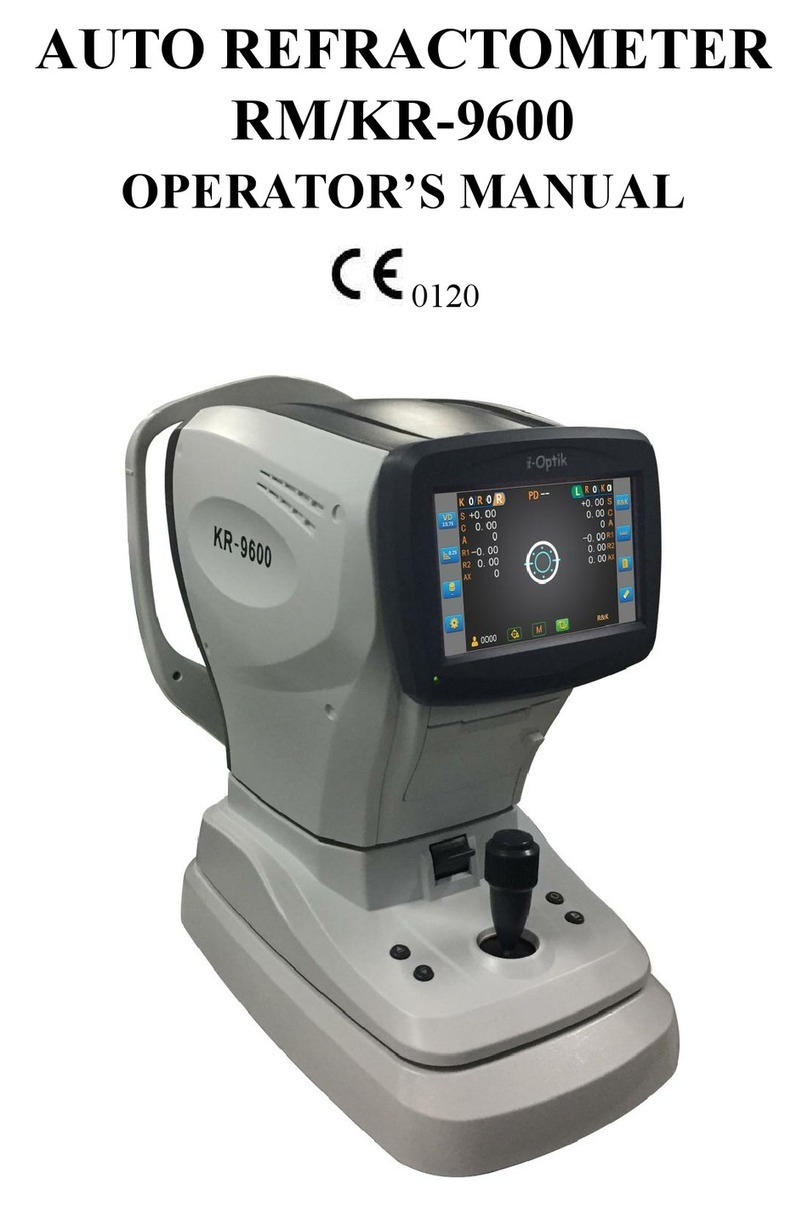
Ningbo
Ningbo RM-9600 Operator's manual

Park House Healthcare
Park House Healthcare RICHMOND ULTRA LOW BED Service manual

Villa Sistemi Medicali
Villa Sistemi Medicali Visitor T15 Technical manual
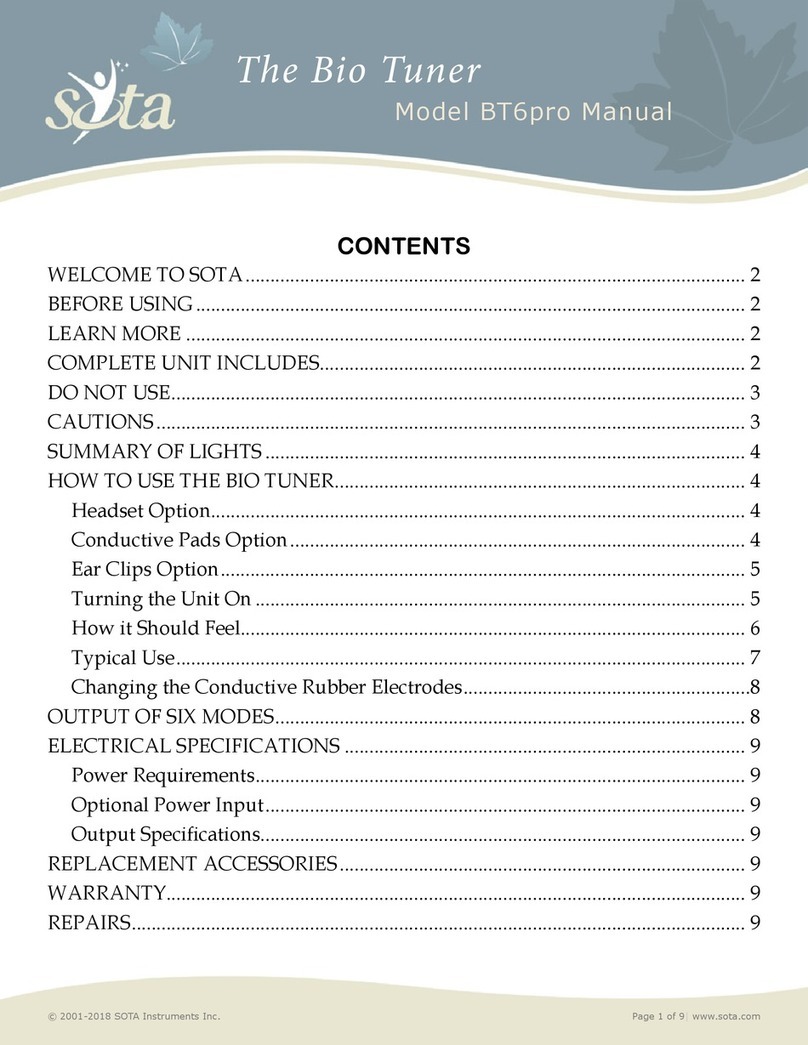
Sota
Sota BT6pro manual
